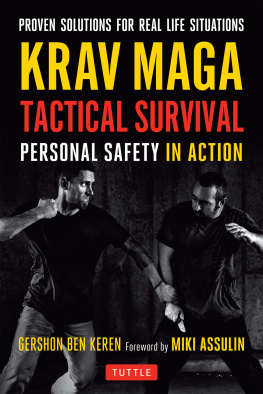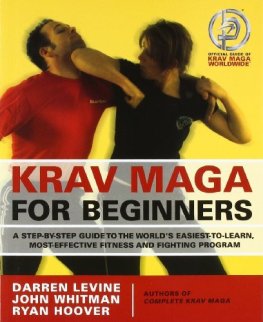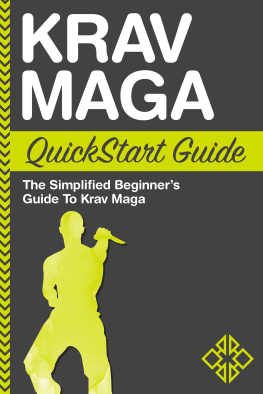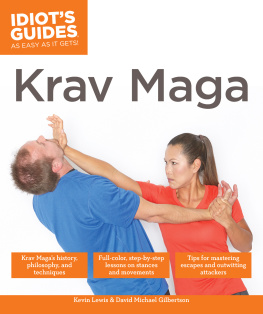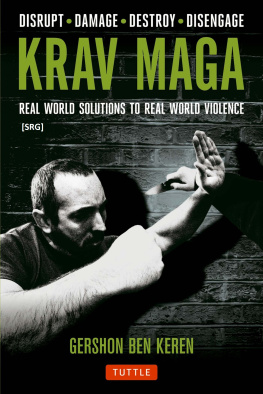Acknowledgments
Writing acknowledgements is always a difficult thing, as one always fears leaving out those who have played a part in the development of the book, even if their contribution was an indirect one. Probably the largest group of indirect contributors to the book have been the students at my schools, who, through their successes and challenges with techniques and solutions, have helped me evolve, refine, and develop the system that I teach, which is reflected in this book.
I would also like to take this opportunity to thank all of my instructors who have taken the time and the effort over the years to help develop me as a martial artist and a person. A special thanks goes to Miki Assulin (one of Imi Lichtenfelds original black belts who was there from the beginning) for his training and teaching, and for giving me a window into the methods, instruction, intent, and original philosophy of Imis Krav Maga. Im indebted to Mikis honesty and integrity concerning his teaching of Krav Maga, and the fact that he has stayed true to the values of the method when many others have promoted themselves over the system. I would like to thank Miki for writing the foreword, and Oren Rippel for translating it from the Hebrew.
As always, special thanks goes to Andy Rallings, for both taking some heavy knocks and falls in the making of the book, and for always making himself available for these projects. His technical contribution over the years has been phenomenal and essential, and I am proud to be associated with him and the SEPS (Situation Effective Protection System) self-protection system that we developed together.
This book would not have been possible without the photography of Colin OReilly. His ability to capture the essence of the techniques when performed at full speed is truly remarkable, and I believe it is one of the major factors which distinguishes this book among self-defense instructional manuals. Colin has been a valued supporter of the system since he first came to train at Krav Maga Yashir Boston, and we are grateful for his efforts, both in the long days of shooting and the tireless editing of each photo afterwards. We could not have hoped to be in better hands.
I would like to thank Efe Atabay for taking some heavy falls (repeatedly) in the throwing section of the book (and for the conversations we have had over the technical aspects, the philosophy and ideas behind the martial arts, etc.); to Scott Campeau and Nick Zagami (who also provided the drawings in the section on de-escalation) for allowing me to kick them over and over again, without complaint; and to Carter Briggs for sustaining the longest bar fight of his life while playing the thankless role of antagonist. I would also like to thank Pat Gagnon for his enthusiastic support and willingness to do whatever is needed to help the schoolin this case, managing to get a photo of a revolver expelling hot gases upon being fired.
A big thank you to Mike Merchant, who organized the shoot at Eddie Cs bar in East Boston, and to Eddie Contilli, Jr., and the Contilli family for letting us use the bar to film in. The use of real locations to shoot the photographs in is one of the things which helps demonstrate the authenticity of the techniques shown.
Last but not least, this book would not be the book it is without the tireless editing provided by Liz Berrien, whose rewrites and revisions give the writing a flow that would otherwise not be present. Her contributions to this, the previous book, and other projects, and her ethic of the good being the enemy of best, are truly appreciated.
Conclusion
Real-world violence can be extremely simple to deal withuntil its not. A straightforward solution to deal with an armed mugger is to control their weapon arm and punch them into unconsciousness, or strike them until you have the opportunity to disengage. This solution will work until you meet the pain-resistant assailant who is drunk, or on drugs, or who has been hit so many times before that your punches barely register with them. It will work until youre assaulted in a confined space where disengagement isnt an option, or in a location where you have little to no room to move (such as on an escalator, or in an elevator). These may be factors youve never experienced in a training environment, and so havent had to consider them. However, they are regular occurrences in real-life situations and need to be thought about and rehearsed. It is all too easy to fall into the trap of believing reality will reflect your training environment. Unfortunately, this isnt often the caseif you train in an open, uncluttered mat space with plenty of room to move, it would be dangerous to assume that you will have the same amount of space in a real-life confrontation. It would be incorrect and dangerous to assume that an assailant wont continue to assault you after youve disarmed them of a weapon, and/or that every firearm you face will be real, loaded, and operable. You need to be prepared for these eventualities and realities. Rather than just practicing Krav Maga techniques, you need to rehearse real-life scenarios, developing your threat recognition and decision-making skills as well as your physical techniques, so that you understand the context of real-life assaults. This is how you will learn to get your Krav Maga to work for you, which should be your goal. Unfortunately, knowing Krav Maga is not enough.
If you train regularly, the assailants you are likely to face in real life will probably not be as physically skillful as you are, or as fit/athletic as you are, yet they may have had a lifetime of being successful at what they donot because of their physical prowess, but because they know how to orchestrate situations to their advantage. The mugger who demands your wallet may well be in a state of withdrawal (most muggings are to support a drug habit), may not have slept for several days or eaten properly in weeks. Yet, even in this reduced physical state, they will have an advantage over youthey understand and know how to use violence; they are prepared to act without conscience; have little or no fear of the legal consequences of their actions; and they believe they are entitled to do whatever they want. They dont rely on physical prowess and abilities; they rely on their understanding of how to play every component in a confrontation to their advantage. They know how to limit any time and space that you may have so you cant respond, how to control and limit your movement, etc. They know how to reduce your ability to fight down to zero. Unless you know how to counter these things, it doesnt matter how much you train your physical techniques and solutions; you will never have the chance to employ them.
By understanding how violent situations occur and develop, you will be able to predict, identify, prevent, and avoid most violent situations; and if not, you will be able to set things up in the environment to be in your favor. This is the way you will get your Krav Maga techniques to work. To do this, though, you need to train yourself in the early identification of threats, how to position yourself relative to your aggressor(s), how to use the environment/geography to your advantage, etc. This means training your Krav Maga in context and in scenarios rather than just mechanically practicing techniques. Train not just to be the person that knows Krav Maga, but to be the person who knows how and when to use it. In the real world, you wont have the luxury not to.
Contents
Please note that the publisher and author of this instructional book are NOT RESPONSIBLE in any manner whatsoever for any injury that may result from practicing the techniques and/or following the instructions given within. Martial arts training can be dangerousboth to you and to othersif not practiced safely. If youre in doubt as to how to proceed or whether your practice is safe, consult with a trained martial arts teacher before beginning. Since the physical activities described herein may be too strenuous in nature for some readers, it is also essential that a physician be consulted prior to training.

